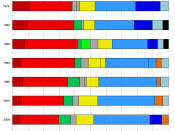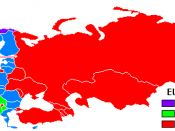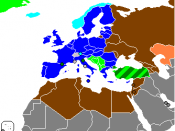Why is policy transfer so fashionable?Policy transfer is by definition the process by means of which knowledge, policies or administrative arrangements shift from one nation or policy making domain to another. The execution is usually carried out by think tanks through the medium of expertÃÂs examinations of other nations or domains before implementation. It is usually thought to be an intentional ÃÂlearningÃÂ process, rather than an unintentional ÃÂevolutionaryÃÂ one where governments facing the same problems discover the same method of resolution. It is also thought to be voluntary, this however is not always the case though it can be of a coercive nature, which will be examined into more depth but usually revolves around money. National governments can compel different sectors or lower levels of government to follow others' practices. Policy transfer is thought to lead to policy convergence and to be part of globalization. Where governments buy services from the same multinational corporations, pressures from the corporations may also lead to convergence and policy transfer.
Because policy transfer is largely about learning, modes of information acquisition are an important aspect of the idea and transfer is supposed to occur more now than in the past due to faster more efficient global communication. The first step towards a decision upon policy transfer and why it has become a fashionable venture is, ÃÂan increasing amount of policy development, and particularly policy change, in contemporary politics is affected by policy transfer. As such, when we are analysing policy change we always need to ask the question: Is policy transfer involved?ÃÂ (Dolowitz and Marsh, 2000: 20) Increasingly Ministers and Number 10 are looking overseas for new policy ideas.
At first glance my initial reaction is to supply the obvious; a Blue Peter, here is one I made earlier. Policy transfer literature hands us this suggestion that when we are ÃÂconfronted with the need to solve a problem, and especially a new problem, there is probably a tendency to search for ready-made solutions in other jurisdictionsÃÂ (Bennett, 1997: 213; also Rose, 1993). Further to this, in situations where the problem area is refreshing, the literature suggests there will be fewer barriers to policy transfer owing to fewer prior commitments, and adoption will be relatively uncomplicated (Rose, 1993: 78; Dolowitz and Marsh, 1996:353). Those recommending solutions to new problems can muster credibility if they can point out that states X and Y are pursuing similar approaches to those they recommend in their home state. This also presents the body governing the search for a solution to save money on research and may also allow the first few steps in the policy transfer cycle to be by passed, thereby saving time as well as vital funds. Taking a deeper look into this I can also see the fashionable rise coming from having a base idea which can be manipulated to suit the specifics.
Policy transfer is also becoming fashionable as it is a way of controlling other countries or policy making organisations. In practice, transfer may involve elements of both coercion and voluntarism: transfer may be forced upon an unwilling political system, but there may be some room to manoeuvre over when or how a policy gets transferred. A good example of this ÃÂnegotiated transferÃÂ (Dolowitz and Marsh, 2000: 15) is the discretion Member States often exercise when putting obligatory EU legislation into practice, especially if imposed under Qualified Majority Voting (Jordan, 1999; Smith, 2001). The development of UK climate policy was not coerced as such. However, the European dimension does play a background role in another sense. EU membership exposed UK civil servants to the values, assumptions and instruments held by their counterparts in other Member States. This Europeanization, operating at the level of meetings in Brussels and through formal and informal networks, opens up channels for voluntary transfer in addition to negotiations over Directives.
I therefore conclude that policy transfer is so fashionable because in a world where globalisation is such a prevalent occurrence we can view the outcomes of policies from other policy making organisations and then transfer them to the uses which suit another policy making organisation. It also has the strengths that it extends the focus of policy analysis and gives the policy making organisation the opportunity to look abroad and see how the other organisations make their policies work. Another strong reflection of how policy transfer is such a fashionable trend is that it challenges policy makers to ask why there are similarities in responses to the policy and the raise the question where do differences come into play.
BibliographyDolowitz, D.P. and D. Marsh (2000) ÃÂLearning from abroad: the role of policy transfer in contemporary policy-makingÃÂ, Governance, volume 13, no 1: 5-24.
Bennett, C.J. (1997) ÃÂUnderstanding ripple effects: the cross-national adoption of policy instruments for bureaucratic accountabilityÃÂ, Governance, volume 10, no 3: 213-33.
Rose, R. (1993) Lesson-drawing in Public Policy, Chatham, NJ: Chatham House.
Dolowitz, D.P. and D. Marsh (1996) ÃÂWho learns what from whom? A review of thepolicy transfer literatureÃÂ, Political Studies, volume 44: 343-357.
Jordan, A. (1999) ÃÂThe implementation of EU environmental policy: a policy problemwithout a political solution?ÃÂ, Environment and Planning C: Government and Policy,volume 17: 69-90.
Smith, A. (2001) ÃÂFitting in with Brussels: implementing the Urban Waste WaterTreatment Directive in England and WalesÃÂ, Journal of Environmental Policy andPlanning, volume 2, no 2: 115-134.





